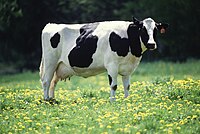
Photo from wikipedia
This study aimed to assess the effects of feeding with different forage sources and starter concentrations on growth performance, nutrient digestibility, ruminal fermentation, and the microbial community in weaned Holstein… Click to show full abstract
This study aimed to assess the effects of feeding with different forage sources and starter concentrations on growth performance, nutrient digestibility, ruminal fermentation, and the microbial community in weaned Holstein calves. A total of 54 Holstein calves (body weight (BW) = 77.50 ± 5.07 kg; age = 70 ± 2.54 days) were assigned to 1 of 3 treatment groups (n = 18/group) that were offered diets with different forages: (1) peanut vine (PV), (2) oat hay (OH), or (3) an alfalfa hay + oat hay combination (alfalfa hay:oat hay =1:1, AO). Starter and forage intakes were recorded daily, while BW and growth parameters were assessed at 15-day intervals. The apparent digestibility of nutrients was determined. Ruminal fluid samples were collected and used to detect relevant indicators. A difference was observed for the forage × age interaction for all feed, nutrient intake, BW, ADG, and body structure parameters (P < 0.05). The final BW, average daily feed intake (ADFI), and average daily gain of the PV calves were higher than those of calves from the other groups (P < 0.05). The ruminal propionate concentration evidently increased in calves of the AO group (P < 0.05). The abundances of Rikenellaceae_RC9_gut_group and Shuttleworthia showed distinct responses to feeding with different forages (P < 0.05) at the genus level. The relative abundance of Shuttleworthia was negatively related to rumen pH and acid detergent fiber digestibility (P < 0.05) and strongly positively related to propionate concentration (P < 0.01). A positive correlation was found between Ruminococcus_1 abundance and butyrate concentration and neutral detergent fiber digestibility (P < 0.05). The relative abundances of Succiniclasticum and Prevotella_7 were negatively related to butyrate concentration (P < 0.05). In conclusion, there was an interaction between the factors (forage × age). The peanut vine used as a forage source promoted a higher starter concentrate intake compared to other diets and increased with the calves' age. The growth performance and rumen bacterial community of the calves were further improved. These results indicate that peanut vine can be used as the main source of forage in the diets of weaned calves.
Journal Title: Frontiers in Veterinary Science
Year Published: 2022
Link to full text (if available)
Share on Social Media: Sign Up to like & get
recommendations!